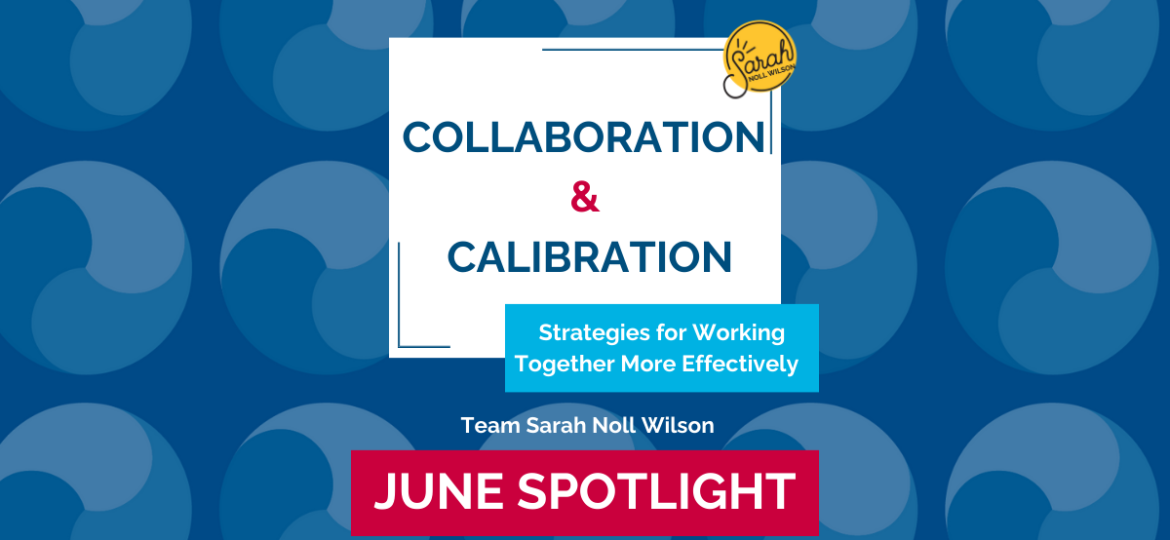
Hello, Friends!
Our focus for June will be collaboration and calibration. We’ll be answering questions like:
- What are the best practices for navigating collaboration among remote or hybrid teams?
- What, if anything, changes during summer months?
- How do you honor one another’s autonomy while pursuing shared goals?
- What are collaborative commitments, why do they generate alignment, and how can you get started creating your own?
- How do you create cultures of psychological safety that make room for the kind of real collaboration that leads to innovation and growth?
- What does honestly calibrating expectations look like, and what can it do to improve our both efficiency and our experience of work?
Learn with us in June! Send your questions and comments about collaboration and calibration to hello@sarahnollwilson.com. We want to hear from you. It’s why we’re here. 🙂
WATCH
READ
Hi everyone. Teresa here from Team Sarah Noll Wilson. I’m really excited to share that the month of June we’ll be focusing on collaboration for our blog and newsletters. That’s a question we often get from you about collaboration, what makes successful collaboration, how to partner. This is an ongoing need that we’re hearing from you. So we’re going to focus on that for the month, and I want to jump in with a quick video newsletter for you related to calibrations.
Sarah and I and our entire team and network are very pro collaboration, pro calibration, so getting specific about how we’ll partner and tinkering, you can think of calibration as some tinkering and some alignment and how the partnership will occur. One tool we’ve talked about before is collaborative commitments, and I want to focus really on what that might look like. For summer. We know common challenges for the teams we serve during summer, total upheaval of the schedule because school is out, parents are balancing completely different schedule than they do the rest of the year.
It’s a different level of energy. We know we often have people going on vacation, people being gone at different times. You might have conferences in the summer. There are all sorts of things that happen. You might have an intern with you who you don’t usually have during the year. So summer is a time with just lots of moving pieces. It’s a great time to calibrate, look very proactively at schedules, at workload, lay all of those pieces over the top of one another, look proactively at what can be adjusted, what can we slow down on? What needs to be sped up on? What are we content waiting on? How will the workflow during absences, that can often feel like a very last minute set. The out of office, just reach out to so-and-So if your hair is on fire and if not, save it till I get back.
But is there a better system that your team can do, a better system that you can create? One of the things the best collaborators do together is that they build systems that work for them, even if they’re not textbook, even if they’re done just by their team and not by the rest of the company or the organization. So what is within your control over your schedule for summer? And I’ll tell you something else. When we think about seeing the whole person, seeing the team member as a whole person, what does summer mean to you? Are there things that you love to do during summer that are only available to you in the summer? How might work? Be able to flex to accommodate those things that you love to do most? Wouldn’t it be wonderful if we could all have the space to say, this is one of my very favorite things.
I can only do it this time of year. A little bit extra free time on a Friday Goes a long way for me. My colleague Sarah was talking with someone recently and they were sharing about time and calibration and her team feels that summer and July specifically was a time that so many memories could be made between staycation or hosting a picnic or whatever it was. That was a very special time in her life outside of work. And so the team was working on how do we make sure we all get some breathing room? How do we flex to make sure we all have some white space, that the page isn’t completely full during that time of year? It would be very common for people to say that will never fly in our organization. And I would say, look for whatever you and your team has control over.
If that’s not part of the culture, I know that that’s very real and that the pressure can be very high. But look for whatever you have control over, even if that’s workflow between you and your handful of colleagues during those summer months and when people are in and out so that we can take rest, right? We are human, we are human beings, not human doings. As I’ve heard said several times lately. Look for the ways that you can enjoy being a human in summer with all of those moving pieces, with the total upheaval. So we would love to hear from you. As always, you can email hello at Sarah, no Wilson, Inc. Did you have a summer calibration? What would you like to do in a summer calibration? Any of the things that we’ve talked about in this short video, I would love to hear from you about.
I will share that one of my favorite summer things is just sitting outside and reading and having my family close. So that’s something my team knows is important to me and we can make just a little bit of space for. So I have no doubt we’ll be having another calibration conversation when we get through the month of June because July is its own very special time for us. So look at the calendar, get proactive, put everything on the table. What can be negotiated. I’m a big fan of embracing possibility. See what wiggle room you can create for yourselves in your team. Again, we love to hear from you. hello@saraholson.com and more to come on collaboration this month. Thanks.
Sarah Noll Wilson is on a mission to help leaders build and rebuild teams. She aims to empower leaders to understand and honor the beautiful complexity of the humans they serve. Through her work as an Executive Coach, an in-demand Keynote Speaker, Researcher, Contributor to Harvard Business Review, and Bestselling Author of “Don’t Feed the Elephants”, Sarah helps leaders close the gap between what they intend to do and the actual impact they make. She hosts the podcast “Conversations on Conversations”, is certified in Co-Active Coaching and Conversational Intelligence, and is a frequent guest lecturer at universities. In addition to her work with organizations, Sarah is a passionate advocate for mental health.


